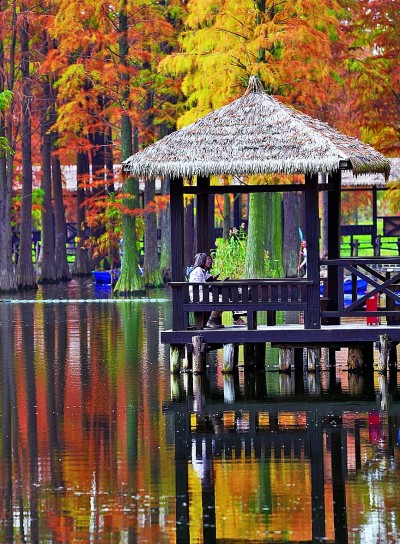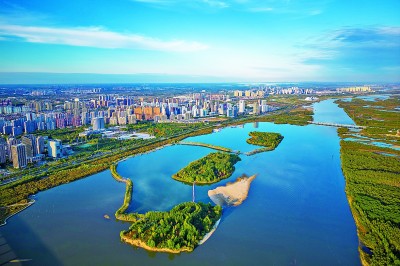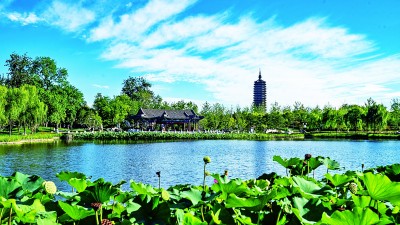In the city, in the forest, enjoy the fresh air of nature.

Shanghai Qingxi Country Park "Water Forest" is picturesque. Xinhua news agency

Tourists visit Shang Hu National Urban Wetland Park in Changshu City, Jiangsu Province. Xinhua news agency

Tourists visit Aershan National Forest Park in Xing ‘an League, Inner Mongolia. Xinhua news agency

Harbin, Heilongjiang Province, strives to create urban wetland signs, highlighting the northern characteristics. Xinhua news agency

Beijing Tongzhou Grand Canal Cultural Tourism Scenic Spot. Photo courtesy of Propaganda Department of Tongzhou District, Beijing
At the beginning of December, a cold air swept the mountains and vegetation from north to south. In Donghai County, Lianyungang, Jiangsu Province, in Xishuanghu National Wetland Park, Metasequoia glyptostroboides and Taxodium distichum are layered in red and sporadic green, showing a warm forest beauty; The high-altitude areas in xuyong county and Gulin counties of Luzhou, Sichuan ushered in the first snow this winter. The mountains and forests were covered with silver and the trees were well-proportioned and well-proportioned.
Around many cities, the forest landscape is within reach. In recent years, the construction of forest cities has been accelerated in many parts of the country, and various eco-tourism and leisure places have been built in cities and suburbs. A few days ago, the State Forestry and Grassland Bureau announced a new list of national forest cities, and awarded the title of "National Forest City" to 26 cities including Shijingshan District of Beijing, Xingtai City of Hebei Province and Lianyungang City of Jiangsu Province, increasing the number of national forest cities in China to 219. In more and more cities, a number of forest parks, country parks and "pocket parks" allow citizens to "push the window to see the green, go out and enter the park" and enjoy the natural fresh air.
The scenery is more beautiful
The forest coverage rate is increasing year by year.
In mid-winter, cold air blows into Yuan Ye, Lingnan. In Shaoguan, Guangdong and other places, forests have been covered with "red clothes". Colorful leaves show the unique natural beauty of the South China in winter.
A few days ago, in the winter series of forest culture week, tourists from all over the world entered the "Cloud Walking" live broadcast room and followed the steps of the host into the ecological corridor of Tianjingshan National Forest Park in Guangdong Province to watch the red leaves. "November to January is a good time to enjoy red leaves in Guangdong." According to the relevant person in charge of Guangdong Forestry Bureau, "Red leaves are mainly maple, cypress, sapium and maple, which are mostly concentrated in northern Guangdong and also distributed in the Pearl River Delta region. At present, the characteristic forest cultural activity system in Guangdong has begun to take shape, and the connotation of forest culture is richer. "
The seasonal changes of forests also add charm to the scenery of the north. In Kaifeng, Henan Province, in the ecological corridor of the Yellow River in the northern part of the city, different tree species are scattered and accompanied by the surging Yellow River water, showing a magnificent ecological picture; In Liaoyang, Liaoning Province, the early morning mist covers the wide water surface, and the branches of trees along the river are dense and oblique, from the banks of rivers such as Taizi River and Gexi River to suburban forest parks and wetland parks. In recent years, extensive afforestation has created a pleasant and livable forest city environment for Liaoyang.
In the list of new national forest cities recently published by the State Forestry and Grassland Bureau, 26 cities including Shaoguan City in Guangdong, Kaifeng City in Henan and Liaoyang City in Liaoning have become new national forest cities. In recent years, the National Forestry and Grassland Bureau issued the National Forest City Development Plan (2018— In 2025), the industry and national standards of National Forest City Evaluation Index were formulated, and a series of measures promoted the construction of forest cities in a scientific and orderly manner, and the construction of forest cities showed a good momentum of vigorous development throughout the country.
“‘ Chuangsen ’ Since its launch, Kaifeng City has completed 33,000 mu of urban greening, built more than 370 parks and green spaces of various types, and the urban greening coverage rate reached 41.7%, and the per capita park green space area reached 15.11 square meters, achieving ‘ See the green at 300 meters and the garden at 500 meters ’ 。” He Junling, director of the Forestry Bureau of Kaifeng City, Henan Province, told reporters.
In Shaoguan, the urban greening coverage rate has increased to 44.99%, the city’s road greening rate has reached 93.43%, the landscape forest along the post road has been upgraded for 26 kilometers, and 75 small parks and small green spaces have been built in three districts under the jurisdiction of the city, and the urban ecological pattern has been optimized day by day.
Better greening, more greenery and more beautiful scenery. The establishment of a batch of national forest cities has greatly promoted the improvement of forest coverage rate in China. In the past ten years, through continuous large-scale land greening, China’s forest area has increased from 3.12 billion mu to 3.46 billion mu, and the forest stock has increased from 15.137 billion cubic meters to 19.493 billion cubic meters. The forest area and stock have continued to "double growth".
Greener.
The ecological environment is constantly improving.
Platycladus orientalis, Prunus persica, Cotinus coggygria, Acer mono … … A colorful mixed ecological forest broke ground in the former barren hills and abandoned mines. In the hilly area of Lincheng County, Xingtai, Hebei Province, the ecological restoration effect of 231 mines gradually appeared. In Xindu District of Xingtai, more than 20 afforestation companies and more than 2,500 professional afforestation teams fought in various afforestation sites, and a tree seedling grew gratifying.
"Since the beginning of this year, with the goal of creating a national forest city, Xingtai City has focused on six afforestation projects, including greening in shallow hills, village greening, river greening, farmland forest network construction, forest tending and restoration of degraded forests, and other afforestation. It is planned to complete 560,000 mu of afforestation throughout the year, further increasing forest resources, improving forest quality and improving the ecological environment." Zhang Erying, Party Secretary and Director of Forestry Bureau of Xingtai City, Hebei Province, told the reporter. According to reports, since 2020, four counties (cities, districts) in the western mountainous area of Xingtai City have vigorously carried out artificial afforestation, closing hillsides to facilitate afforestation, aerial seeding afforestation and other projects, and completed more than 700,000 mu of afforestation, with a forest coverage rate of over 48%.
According to the "National Forest City Evaluation Index", national forest cities should achieve a green coverage rate of more than 35% in urban built-up areas (including built-up areas in cities and counties under their jurisdiction) and a green space rate of more than 33%; Pay attention to natural ecological protection along rivers, lakes, seas and other water bodies, and the greening rate of waterfront reaches over 80%; There are many leisure green spaces in the built-up area, which are mainly parks and public green spaces. Most citizens have leisure green spaces when they go out for an average of 500 meters. At the same time, it also requires the city to realize the combination of nature and humanity, the integration of history and culture with urban modernization, and the rational layout, sound functions and beautiful landscape of urban forests.
In the creation of forest cities, all localities have promoted urban greening through multiple ways. In Tongren, Guizhou, Wujiang River, Jinjiang River and other important rivers, important wetlands, and the banks of the downtown areas of all districts and counties, greening and landscape have been continuously improved, and a number of urban parks and citizens’ leisure spaces have been built.
Faced with the problems of industrial site renovation and ecological environment management, a number of cities have achieved the integrated development of natural and human landscapes through ecological restoration and diversified greening. In Tongzhou, Beijing, the former Oriental Chemical Plant, East Asia Aluminum and other old industrial sites, the urban green heart forest park replaced the once heavily polluted old industrial zone, and the natural forest landscape and waterfront space became "urban green lungs".
Wang Xiang, vice chairman of China Landscape Architecture Society, pointed out that urban greening is an important infrastructure of the city, which provides beautiful and livable living environment for the people, and plays an important role in maintaining urban ecology, creating urban public space characteristics and promoting the healthy development of urban economy and social system. In the new historical stage, urban greening construction needs to be based on the new development concept, focus on the optimization of urban living environment, and play an important role in urban ecological civilization, urban renewal and urban space quality improvement.
More tourists
The popularity of forest tourism has increased.
Covered with green, springs, ponds, waterfalls and gorges are dotted, and the characteristic farmhouses with white walls and red tiles are scattered. In Xueye Street, Laiwu District, Jinan City, Shandong Province, Fanggan Village, located halfway up the mountain, attracts an endless stream of tourists with green mountains and green waters.
To the surprise of many tourists, this village with a forest coverage rate of 97% once had "no road to the village, no trees on the mountain, no water in the ditch, no food at home and no room to live in". After two generations of hard work, Fanggan village completed the butterfly change by harnessing mountains and controlling water, planting trees and adjusting industrial structure. "In recent years, the village has continuously expanded its eco-tourism products, achieving the goal of promoting tourism through forests and enriching farmers through tourism." Talking about the changes and gains in the village, Han Chao, secretary of the Party branch of Fanggan Village, said that the village now receives 500,000 tourists a year, with a per capita net income of 35,000 yuan. Relying on natural resources such as mountains and forests, the villagers have eaten "tourist meals".
In recent years, the forest has become a popular destination for people to travel with its unique advantages of nature, quietness and "natural oxygen bar". Not only forest tourism and eco-tourism, but also relying on ecological resources such as forests, grasslands and wetlands, forest recreation, forest hiking, forest camping and popular science research are also developing continuously.
"Forest health is a new format of forestry industry, which is related to ‘ Two mountains ’ An important industry of national strategies such as transformation, healthy China and old-age care. " Liu Dongsheng, deputy director of the State Forestry and Grassland Bureau, pointed out that during the "Thirteenth Five-Year Plan" period, the State Forestry Administration, the Health and Health Commission, the Ministry of Civil Affairs and the Bureau of Traditional Chinese Medicine jointly issued guiding opinions and named a number of national-level forest rehabilitation bases, which clearly defined the development of this new format and built a platform. During the "Tenth Five-Year Plan" period, it will continue to be a key supporting industry to further improve policies and standards, so that forest health will play a greater role in ecological priority green development.
In Guangxi, which is rich in forest resources, forestry eco-tourism and forest health industry have developed rapidly. At present, Guangxi has built 158 forest health care destinations such as natural parks, nature reserves and forest homes, and created 62 forest health care bases, becoming an important forest health care distribution center in China. The data shows that in 2021, Guangxi’s forestry eco-tourism and forest health care industry received about 145 million tourists, with a total consumption of over 130 billion yuan, accounting for more than 20% of the total income of the cultural tourism industry in the region.
The construction of national forest trails is also being actively promoted. Since 2017, the State Forestry and Grassland Bureau has successively announced three batches of 12 national forest trails, including the Qinling Mountains, Taihang Mountains, Daxing ‘anling Mountains, Wuyishan and other national forest trails, passing through 20 provinces along the route, with a total mileage of more than 22,000 kilometers. Shaanxi Forestry Bureau recently announced the third batch of eco-tourism characteristic routes to further enrich the eco-service products such as forest tourism, natural experience and research tourism. From Xiangyu Forest Park and Taiping National Forest Park in Xi ‘an to Qinling Botanical Garden and Tianyuhe National Wetland Park in Xi ‘an, visitors can enjoy the forest scenery of Qinling Mountain by traveling on Damei Qinling Eco-tourism route.
Relying on rich forest types and biodiversity endowments, various places have also launched distinctive forest tourism routes and cultural activities. In recent years, Guangdong has launched 100 characteristic forest tourism routes, 100 emerging brand sites, and built five national forest health bases. Eco-tourism has become one of the important green industries. In Beijing, brand activities such as forest concert, forest summer camp, "Yue" reading forest and forest caravan meet with tourists. The park scenic spots in the city carry out more than 500 special cultural activities every year, receiving 360 million tourists every year.
(Reporter Yao Yaqi)